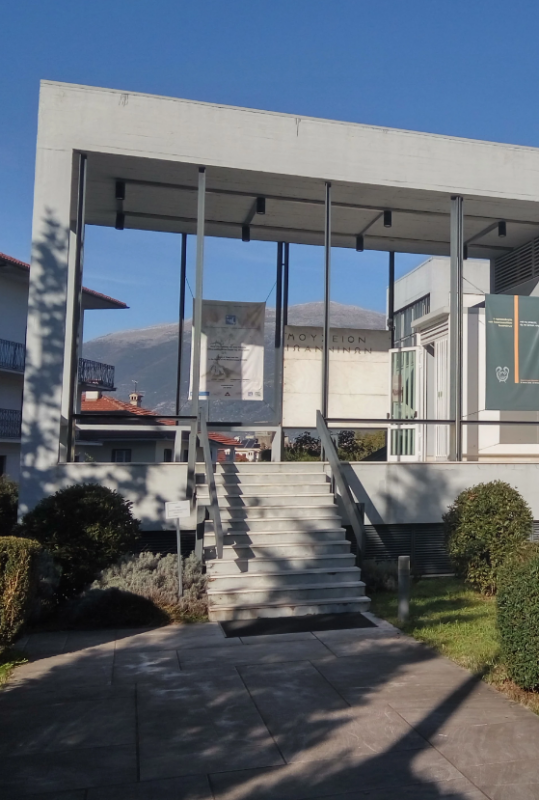Epirus showed the first sign of life 250,000 years ago. The archaeological museum of Ioannina goes through the centuries from the Paleolithic period to the Roman Empire and tells stories about the people and achievements of the land of Epirus. Approximately 3,000 objects are linked to life: a dazzling ring of gold and silver depicting the murder of Clytemnestra by Orestes, a bronze shield, a turtle- rattle made of clay. Others are linked to death: a golden wreath with oak leaves, a marble sarcophagus. Others to gods and folklore: thousands of bronze shrines, i.e. leaden films on which the believers carved questions to the gods at the oracle of Dodona.
1. The Archaeological Museum of Ioannina
In this museum you will find an oracle for the people, archers, elephant warriors and Neanderthals, among others. This museum-monument is dedicated to the people of Epirus and has many surprises.
Stories
A 250,000 year journey
"Archaeologists" for their own benefit
In the time of Ali Pasha of Ioannina, the antiquities of the area were being encroached rapidly. Simple villagers sold ancient items to the foreign "milords" (travelers, antiquaries and scholars), who took them back to their homeland. Sometimes they simply turned marble artworks into lime for their needs. Ali Pasha himself gave the "luminous" example by ordering to dig in the ruins of Nickopolis in order to reap the treasures and remove marbles for his Serai in Preveza.
Perks of the job
In 1875, Konstantinos Karapanos, a politician and banker from Arta, begins excavations in the valley of Tomar, with the engineers Mineiko and Petrovsky as supervisors. Early excavators discover the ancient chancel-oracle of Dodona and become owners of precious ancient objects. The largest part of the collection of Karapanos is donated to the Archaeological Museum of Athens. Other findings, mainly from Mineiko's collection, end up in the Louvre, the Berlin Museum, the British Museum and other museums around the world.
Looking for Neanderthals
Tens of thousands of years ago nothing resembled Epirus. The mountains were covered by many meters of ice. The Adriatic was not a sea, but a vast plain. Corfu was not an island but part of the mainland. In the gorges and the labyrinthial valleys, alongside rivers and swamps, lived wolves, deer with big horns, and some other two-legged creatures with robust bodies and protruding eyebrows. These were the Neanderthals, who lived by hunting and collecting fruits from nature and who left their traces in several corners of Epirus (Asprochaliko, Kokkinopylo, Karvounari). Archaeologists have not found their skeletons but have found their stone weapons and tools instead, such as scrapers to soften peltry, shellfish beads and much more evidence of their resourcefulness.
A present for Zeus
In 274 BC, Pyrros, a tireless military master, has just returned from his expedition in Italy. A series of defeats has faded his aspirations for an Epirus that will spread beyond the sea. But he sets new goals. He invades the neighboring Macedonia. Macedonia’s king, Antigonos Gonatas, reacts and expedites against Epirus. Pyrros is waiting for him on the banks of the Aoos River, leading an army of infantrymen, horsemen, Galatian mercenaries, and elephants. The victory gives him Upper Macedonia and a large part of Thessaly, so Pyrros consecrates copper Macedonian shields and spoils from the rival army to the sanctuary of Zeus at Dodona. The small part of copper coating with traces of the inscription "ΒΑ[ΣΙ]ΛΕΥΣ", which is kept in the museum today, was probably part of one of those commemorative shields.
The "gallery" of the ancestors
In the 2nd century A.D. a wealthy resident of the Roman-occupied Epirus, orders a marble sarcophagus for his last trip. He asks to the artist who will make it that its long sides demonstrate a scene from the war of Troy: Priamos, the father of dead Hector, bringing a ransom and asking Achilles to hand over the body of his son. The choice in decoration is not accidental. According to the myth, the son of Achilles, Neoptolemos, after the Trojan events, settles in Epirus with Andromachi, the widow of Hector. Their son is Molossos, primogenitor of the royal dynasty of Aiakides of Epirus. Pyrros, the most prominent member of the dynasty, appreciates his family connection with the hero, and in order to widely remind this connection, he has silver coins and staters cut, with the forms of Achilles and his mother, Thetis, printed on them.
Who stole the wool from the mattress?
On the shrine films, namely the leaden films with the questions of the believers to the gods of Dodona, faces lost in the anonymity of history acquire names and their concerns become specific: Theonas asks if his daughter will be married well, Myrta wonders if she will be a widow, Klephnika wants to have children and asks if she ought to choose another husband to succeed, Mnaseas is anxious about the health of his daughter, Aristocrat considers buying donkeys and asks if his business move will be successful, a cook sank into debt wonders whether it is advisable to change professions, the slave Kittos wants to know if his master will release him as promised. The questions are human. Some timeless, others more humble, yet important to the questioners. Like the unknown man who does not hesitate to trouble the gods to find out if a slave or an acquaintance of his stole the wool that filled the mattress.
Powered by Clio Muse Tours
